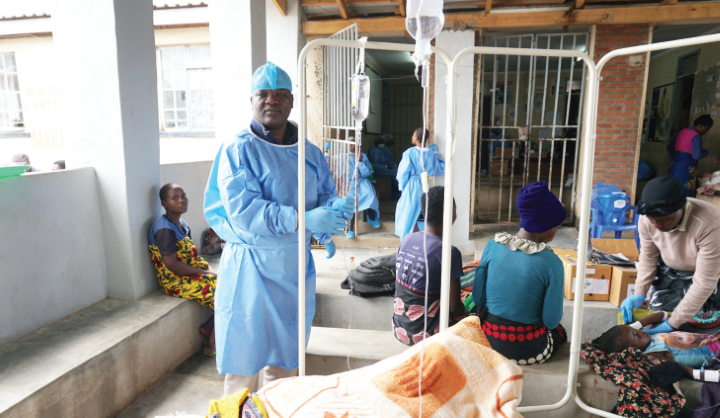Side effects in ARVs, another thorn in HIV, Aids fight
For Davson Mkandawire (47) of Senior Chief Lukwa in Kasungu, but based in Chirimba Township in Blantyre, the phased out Stavudine regimen-based therapy for HIV and Aids made his life dreadful. He has been on antiretroviral (ARVs) drugs for nine years and says it is by grace of God that he is alive.
Mkandawire says the years of taking Stavudine were an agony of adverse side effects. He says he was first diagnosed with HIV in 1997, but had no access to any therapy until government introduced free ARVs.
 He recalls the situation before ARVs: “Every day, my life was on the edge of death. I was living on painkillers. Everywhere I went, even if it is within my community, I had to keep some painkillers in my pocket. This was because my body was prone to any infection and in a day, I could be attacked by different diseases.”
He recalls the situation before ARVs: “Every day, my life was on the edge of death. I was living on painkillers. Everywhere I went, even if it is within my community, I had to keep some painkillers in my pocket. This was because my body was prone to any infection and in a day, I could be attacked by different diseases.”
Introduction of ARVs was a relief not only to Mkandawire, but hundreds others living with the virus. A 2007 journal article by sociologists and lecturer at the University of Malawi’s Chancellor College the late Dr Pierson Ntata titled Equity to Access in ARVs in Malawi indicates that the first people that were put on ARVs contributed K2 500 per month.
But success was around the corner. Since ARVs became free, the number of people accessing the therapy has been increasing, and indisputably, the rate at which Malawians die to HIV and Aids has been dwindling tremendously. By 2006, the journal reports that 85 000 Malawians were dying of HIV and Aids annually.
Today, the death rate is at 47 000 per year and this is being attributed to the free ARVs. In December 2014, UNAids country director Amakobe Sande said 130 Malawians die of HIV and Aids every day. This is down from 233 per day in 2004.
Quite motivating is that slightly over 500 000 Malawians are on ART now and the prevalence rate of the virus has dropped from 14 percent in 1998/2000 to 10 percent in 2014.
This chains the Millennium Development Goals (MDGs) goal number six on HIV and Aids, which encourages countries to reduce new infections and promote access to ARVs. Nonetheless, despite these successes, side effects have been influencing people to shun the therapy.
Mkandawire reveals that there was a time when he could not see the reason to continue with Stavudine because of its sundry side effects.
“They disfigured my face,” he recalls, “I could not eat because was always nausea, was constantly tired, felt dizziness, my face was swollen and lacked balance when walking,”
This is what most people taking Stavudine have been going through.
However, in medicine, drugs have side effects.
So, is Tenofovir a solution?
Our investigations show that the therapy represents a 50-50 situation. Those it has favoured are singing praies while others are in another hell of complicated side effects.
Mkandawire says he has been in both circumstances. He says the moment he was introduced to Tenofovir recently, his health turned worse.
“It was the worst ever health condition. I felt dizziness, headache, nausea, could not think properly and had sleepless nights,” he says, adding that he is now better.
So too is Zamveka Mussa of Mbayani Township. He laments that his body is still struggling to adapt to the new therapy. He reveals that he cannot walk due to dizziness, each meal he eats is lost to vomiting and his body too continues to swell and his breasts are growing big. His wife Jenipher says the husband sometimes behaves like is mentally ill. She adds that when they went to the hospital recently, doctors recommended that he should be put on a different therapy if he does not improve by end of May.
These two cases represent the situation on the ground and are supported by a research by Yohane Gadama, a Bachelor of Medicine and Bachelor of Surgery (MBBS) student at College of Medicine titled Impact on Compliance with the Change of First Line Anti-Retroviral Drug Regimens that focuses on Tenofovir. The paper reveals that the therapy has several side effects that are more visible during the first weeks.
The research found that the side effects mainly affect the mental system. It lists dizziness, drowsiness and nightmares as common side effects. The paper also finds a case like Mussa’s. One of the 57 sampled men developed big breasts.
Manet+ programmes manager Eddie Banda admits observing adverse side effects in HIV and Aids patients. He adds that, he has met male patients developing big breast apart from other adverse side effects such as hallucinations.
But he defends the situation saying Tenofovir is the best choice and it is WHO that recommended the drug. He says Stavudine was the worst than the latter and adds that many patients have registered better results after a number of weeks.
“Tenofivor’s side effects appear during the first three weeks and when they disappear, it is for good. For those not improving, they are being prescribed another therapy,” says Banda, adding there are other regimens, but it is WHO that determines.
Master Mphande, executive director for National Association for People living with HIV and Aids in Malawi (Napham) says: “People react differently to medication. However, comparatively with the previous regimen, the current one has fewer side effects than the previous,”
Gadama’s paper, which is to be presented in the Netherlands in June this year recommends intensive counselling and follow ups on each patient on therapy saying the side effects can affect adherence to the drug.
Both Mphande and Banda call for concerted efforts to reach every patient. They say despite that this is the norm, there is need for an extra gear especially in the rural areas.
Although Tenofovir is new in Malawi, countries such as Zimbabwe, Botswana and Zambia have been using it for about a decade now.
A private medical practioner in Harare Tichawanda Guma told the Herald of Zimbabwe that the country plans to change the therapy in line with WHO recommendations soon.
In Botswana, Tenofovir is used on conditions. Botswana National HIV and Aids Treatment Guidelines says the Tenofovir should be given to children at tanner four and below to avoid bone demineralisation and should not be given to pregnant women, anemic patients and when serum creatinine cannot be created.





